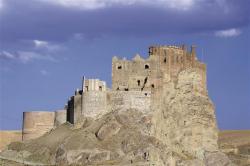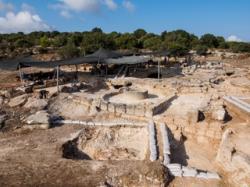INSTITUT SUPERIEUR D'ANTHROPOLOGIE
INSTITUTE OF ANTHROPOLOGY
ONLINE COURSES / COURS A DISTANCE
FALL TERM : OCTOBER 2014
REGISTER NOW
TURQUIE –  Van -Excavation and restoration works in Van’s Hoşap Castle have unearthed a 400-year-old cistern in a castle that has already attracted attention from tourists. Mehmet Top, the head of the excavation team and a professor at Van Yüzüncü Yıl University, said the cistern could be reached through stairs in the castle. He said this year’s works focused on the seraglio and the view terrace in the northeast of the castle. The excavation team worked to unearth the castle’s upper layers, an exit road, pipes and ceramic pieces. Top said the cistern, which is located by a staircase leading from a 160-centimeter corridor, was the most important find in the castle so far, however. “In this way, we have shed light on how people met the need for water in the castle,” Top said. The centuries-old cistern aided recent excavations, as well. Top explained the cistern’s use as a water depot this year solved water shortages the excavators had faced while working in the castle in previous years. “We carried water by tankers and filled the cistern,” he said. “It is a great opportunity for us. The cistern contributed to excavation works.”
Van -Excavation and restoration works in Van’s Hoşap Castle have unearthed a 400-year-old cistern in a castle that has already attracted attention from tourists. Mehmet Top, the head of the excavation team and a professor at Van Yüzüncü Yıl University, said the cistern could be reached through stairs in the castle. He said this year’s works focused on the seraglio and the view terrace in the northeast of the castle. The excavation team worked to unearth the castle’s upper layers, an exit road, pipes and ceramic pieces. Top said the cistern, which is located by a staircase leading from a 160-centimeter corridor, was the most important find in the castle so far, however. “In this way, we have shed light on how people met the need for water in the castle,” Top said. The centuries-old cistern aided recent excavations, as well. Top explained the cistern’s use as a water depot this year solved water shortages the excavators had faced while working in the castle in previous years. “We carried water by tankers and filled the cistern,” he said. “It is a great opportunity for us. The cistern contributed to excavation works.”
http://www.hurriyetdailynews.com/centuries-old-cistern-contributes-to-excavation-.aspx?pageID=238&nID=71929&NewsCatID=375
ISRAEL –  Bet Shemesh - A walled compound dating to the Byzantine period has been discovered west of Jerusalem, in the neighborhood of Bet Shemesh. The compound, which has residential and large-scale industrial areas, may have been used as a monastery. “The finds indicate the local residents were engaged in wine and olive oil production for their livelihood,” excavation director Irene Zilberbod of the Israel Antiquities Authority told the Xinhua News Agency . Several colorful mosaics were found in the residential areas—one featured a cluster of grapes surrounded by flowers and set in a geometric frame. Two ovens were also uncovered. “The magnificent mosaic floors, windows, and roof tile artifacts, as well as the agricultural-industrial installations inside the dwelling compound, are all known to us from numerous other contemporary monasteries,” Zilberbod said.
Bet Shemesh - A walled compound dating to the Byzantine period has been discovered west of Jerusalem, in the neighborhood of Bet Shemesh. The compound, which has residential and large-scale industrial areas, may have been used as a monastery. “The finds indicate the local residents were engaged in wine and olive oil production for their livelihood,” excavation director Irene Zilberbod of the Israel Antiquities Authority told the Xinhua News Agency . Several colorful mosaics were found in the residential areas—one featured a cluster of grapes surrounded by flowers and set in a geometric frame. Two ovens were also uncovered. “The magnificent mosaic floors, windows, and roof tile artifacts, as well as the agricultural-industrial installations inside the dwelling compound, are all known to us from numerous other contemporary monasteries,” Zilberbod said.
http://www.newkerala.com/news/2014/fullnews-104250.html
TURQUIE –  Patara - This year’s archaeological excavations in the ancient city of Patara, located in the southern province of Antalya’s Kaş, have ended. Among the findings this year were the statuette of the goddess Asteria and a seal owned by the Egyptian king Ptolemares and his wife Arsinoe. The excavations in the ancient city of Patara, one of the six big cities of the Lycia Union, have been continuing for 26 years. This year 30 academics, five archaeologists, 14 archaeology students and 20 laborers worked for 2.5 months in the ancient city. In addition to the goddess statuette and the seal, a Lydian coin dating back to 610-570 B.C. and a figurine from 3,000 B.C. were unearthed this year in the area. Head of the excavations Professor Havva İşkan Işık said they had worked in three areas, including the Tepecik Acropol, Port Bath and Great Basilica. “Among the findings, the figurine, from 3,000 B.C., the early Bronze Age, made us the happiest. It gave us clear information about the history of Lycia,” she said. As for the coin, the professor said, “This is one of the secondary emission coins printed right after the first coin in history. It is the earliest coin discovered in the Lycia area. There was also a road guide monument that we found many years ago. It shows the distance between all of the cities of Lycia. A milestone of this monument is also among this year’s findings.”
Patara - This year’s archaeological excavations in the ancient city of Patara, located in the southern province of Antalya’s Kaş, have ended. Among the findings this year were the statuette of the goddess Asteria and a seal owned by the Egyptian king Ptolemares and his wife Arsinoe. The excavations in the ancient city of Patara, one of the six big cities of the Lycia Union, have been continuing for 26 years. This year 30 academics, five archaeologists, 14 archaeology students and 20 laborers worked for 2.5 months in the ancient city. In addition to the goddess statuette and the seal, a Lydian coin dating back to 610-570 B.C. and a figurine from 3,000 B.C. were unearthed this year in the area. Head of the excavations Professor Havva İşkan Işık said they had worked in three areas, including the Tepecik Acropol, Port Bath and Great Basilica. “Among the findings, the figurine, from 3,000 B.C., the early Bronze Age, made us the happiest. It gave us clear information about the history of Lycia,” she said. As for the coin, the professor said, “This is one of the secondary emission coins printed right after the first coin in history. It is the earliest coin discovered in the Lycia area. There was also a road guide monument that we found many years ago. It shows the distance between all of the cities of Lycia. A milestone of this monument is also among this year’s findings.”
http://www.hurriyetdailynews.com/excavations-in-patara-end-with-surprizing-discoveries.aspx?pageID=238&nid=71890&NewsCatID=375